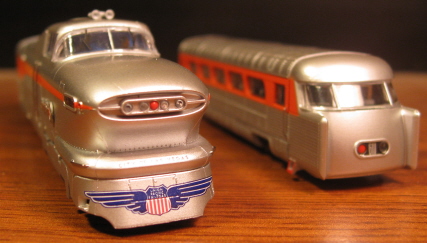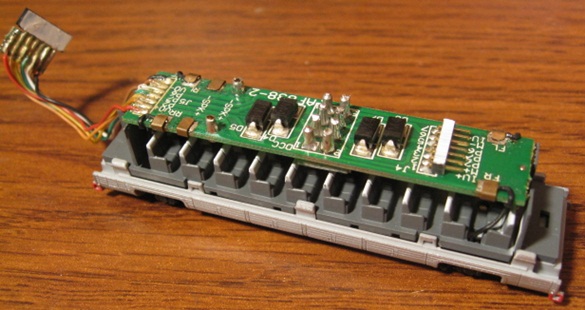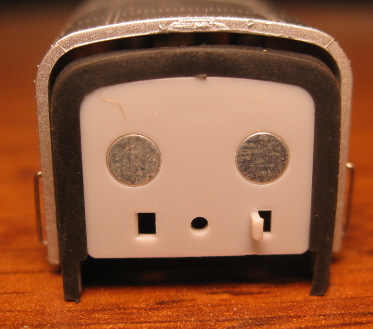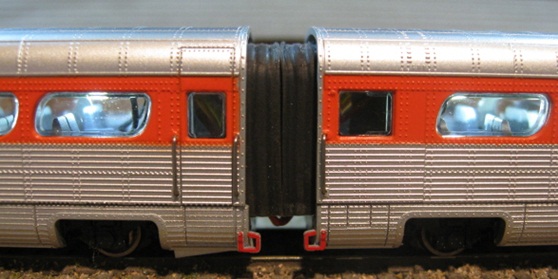







Introduced: 2008
Con-Cor's AeroTrain was the follow up release to their successful Pioneer Zephyr and Galloping Goose models. Unfortunately, ye olde AeroTrain can't really hold a candle to either of those two releases as it's pretty iffy as a runnable model. It's also pretty strange looking (basically resembling a bunch of buses chasing an amusement park ride spaceship). Still, I don't suppose we can hold Con-Cor responsible for GM's poor taste...
The AeroTrain is sold as a complete four unit train - an "A" (engine), a "B" (coach), a "B-DCC" (coach), and a "C" (tail-end observation). Three-car add-on sets (all coaches) are also available. All cars have fully detailed interiors as well as interior lighting. The engine has cab interior detailing that includes a couple of actual engineers (AFAIK, a first for N scale).
All propulsion elements (motor, etc) are housed inside the engine -

The engine chassis is all metal and quite heavy. The five-pole motor is open-sided and skew-wound. Dual flywheels are mounted to the driveshafts. The forward truck has two axles, whereas the rear truck only has one. All axles are geared and all gearing is plastic. The wheels are blackened and low-profile. All but the forward two wheels are equipped with traction tires. So, with only two wheels providing pickup, don't expect this engine to run until you've hooked it up to one or more of the coach units (all of which provide pickup).
Con-Cor's AeroTrain is fully DCC-Ready, with an 8-pin NMRA decoder socket provided inside the "B-DCC" coach. Said B-DCC coaches are easily differentiated from the "normal" coach units by their speaker holes (on the bottom). And although (at first glance) there doesn't appear to be anyplace to actually put a decoder, the seating is designed with a "breakaway" section that, once removed, leaves room enough for a decoder and speaker (all of which is covered in the included instructions) -

As mentioned above, all cars provide electrical pickup. Current is routed between the coaches and the engine by a series of wiring harnesses and socket-equipped PC boards. Said PC boards also provide both interior and exterior LED lighting. The locomotive has directional, bi-color headlights (white when moving forward and red when backing up). Similarly, the taillight on the observation car changes from red (when going forward) to white (when backing up).
Connecting up all the plugs and sockets requires that the shells be removed from each of the coaches - a somewhat annoying procedure that seems to be a prescription for damaging the paint on the sides of the coaches...

One of the really innovative features of this train are the diaphragms between each of the cars. These are extremely realistic looking and, believe it or not, they're actually held together by magnets (I kid you not). Small plastic posts on either diaphragm "face" help to keep the magnetic connection properly aligned -


Overall performance is a bit uneven. On the plus side, pickup is great (well, no surprise there, what with virtually all the wheels collecting current). Further, the engine runs nice and quiet, and its pulling power is respectable. Unfortunately, the train (as delivered) is pretty much useless on curves sharper than 19"-radius. The trucks barely pivot, so 9.75"-radius curves are completely out of the question (the wheels will instantly derail). And although 11"-radius curves aren't necessarily an "instant derail", hopping the rails on said curves does seem to be a virtual inevitability. Adding a small amount of weight (less than an ounce) to each of the coaches will go a long way towards solving this problem. For mine, I added some skinny cylindrical weights to the aisles between the seats (not visible through the windows). I also added a bit of tungsten putty to the ceiling of each car. Once weighted down, I no longer had any problems with the cars derailing on 11"-radius curves.
Slow speed performance tends to be a bit uneven, with mine unable to be maintain any sort of constant speed at low throttle settings. The engine also has a bit of a wobble to it as it rolls along (no doubt owing to all those traction tires). I also had some pickup issues (flickering lights, stalls, etc) after about an hour of running time. I eventually traced the problem to the PC boards - specifically the little metal clips that hold the truck wires to contacts on the boards. About half of my AeroTrain's clips weren't doing their jobs, basically eliminating half of its pickup. However, simply clamping the clips down tighter with a needlenose pliers took care of that problem.
The real dealbreaker for me is the trucks on the coaches. First off, all of the wheel gauging is a bit tight as delivered (making Atlas Code-55 turnouts virtually impassable). And although regauging the wheels solves that problem for the most part, I still can't get mine to run reliably through turnouts (even Kato Unitrack turnouts). I don't know if the problem is due to the limited pivot of the trucks, the tight diaphragms, or all of that wiring between the cars, but inevitably one of the trucks will pick the wrong direction through a turnout and derail the train. Adding insult to injury, the derailed wheel can actually melt the truck if you're running on DCC and don't catch it fast enough.
So, ultimately a fairly unimpressive model (for me, anyway). Sure, people who "just gotta have an AeroTrain" will probably find fixes for all the various shortcomings. As for those of us who are less than enamored with the prototype, well, this will probably be a model that we can live without (especially given the hefty pricetag).
Update - Con-Cor finally copped to the fact that they did in fact neglect to include the requisite weights for these cars when they were first produced, and will (at least as of this 2023 writing) provide them for free to those who ask for them.
Prototype information -
There were two AeroTrain consists (#1000 and #1001). These were built in 1955 and debuted at the 1955 "GM Powerama" (held at Soldier Field in Chicago). The two AeroTrain demonstrators logged over 600,000 miles traveling from coast to coast, and were open to the public for viewing in many major cities. The AeroTrain saw regular service on a number of railroads (PRR, NYC, UP, ATSF, and RI), as well as making more brief appearances on others (SP, NH and CN). Today you can find parts of one AeroTrain at a museum in St. Louis, and parts of the other at a museum in Green Bay. The one in St. Louis was cosmeticly restored in 2003 (using a $10,000 donation from the the NMRA). Each AeroTrain consisted of the locomotive unit, eight 40-seat coaches and the tail end observation car (a total of 10 units per train). The locomotive used the drive train from the SW-1200 switcher (regeared so it could hit a top speed of 102 mph). The car bodies were built using parts from an inter-city bus body that GM was building at the time. The GM designer responsible for the AeroTrain project, Charles "Chuck" Jordan, is retired and living in Southern California. "Chuck" was the primary designer of the 1958 Corvette, and was named Cadillac s Chief of Design in 1959.
To remove the engine shell, simply insert a couple of toothpicks between the chassis and shell (on both sides). The shell should come up and off readily at that point (the included parts diagram shows exactly where to insert the toothpicks).
To remove the shell from a coach, insert tooothpicks in the seam between the coach body and the chassis. Pop loose the chassis clips and the shell should come right off. Just be careful sticking your toothpicks (or whatever) in that seam - it's a tight fit.
Grade: C
Reviewed 07/09 Model Railroader ("Following the success of the HO scale Aerotrain, Con-Cor now offers this articulated passenger train in N. The ready-to-run model is designed for direct-current layouts, but provisions are included for adding Digital Command Control and sound. Like the HO scale version, the N Aerotrain LWT12 has a finely detailed injection-molded plastic body shell with separately applied wire grab irons, a detailed cab interior with two painted crew figures, and clear window glazing with printed windshield wipers. The body shell is held on the frame by six tabs (three on each side) that are evenly spaced between the front truck and rear axle. The locomotive has a die-cast metal chassis, which accounts for most of the train's 5.7 ounces of weight.
"A five-pole skew-wound motor is seated in the fuel tank with a printed-circuit (PC) board on top. The locomotive has two traction tires to increase pulling power. Since the non-traction-tire equipped wheelsets on the locomotive and the wheels on all the cars pick up electricity, the train runs through turnouts without stalling. The four-axle Flexicoil truck is covered by skirts attached to the chassis. The skirts pivot freely, allowing the locomotive to negotiate tight curves. The single-axle rear truck also has some play so it can follow curves. The blackened nickel-silver wheels are mounted on split axles and are correctly gauged.
"Performance. The Aerotrain started moving at 3 volts with a rather jerky motion, but began to smooth out around 4 volts. The train achieved a top speed of 156.3 scale mph, 54 mph faster than the prototype. The locomotive's 1.9 ounce drawbar pull should be sufficient to pull a nine-car train. Beams from a group of light-emitting diodes (LEDs) are reflected through plastic light bars to illuminate the nose headlights and number boxes. In reverse, the red marker light on the locomotive and white light on the tail car are illuminated. I also ran the Aerotrain on our N scale Carolina Central layout, and it passed over turnouts and the 9 3/4" radius curves smoothly.
"The coaches and tail car have crisp fluting and rivet detail. All three cars have press-fit window glazing, wire grab irons, and dark gray seats with white headrest covers. Each car's interior is illuminated with LEDs. The passenger cars ride on single-axle trucks. The metal wheels (mounted on plastic axles) were out of gauge on all three cars. I fixed them by twisting the wheels back into gauge. Since the four-unit Aerotrain is wired as one circuit, the cars need to be oriented with the vestibule forward so the electrical connections can be made. The eight-pin plug from the locomotive and each coach must be connected to the socket in the adjacent car. The full-width vinyl diaphragms are cleverly designed. Each one is mounted on a steel pin so it can move as the train operates on curves, and magnets in the striker plates hold the cars together so they don't separate. Per the manufacturer's recommendations, the wires from each eight-pin plug should be run under the diaphragms so they can move from side to side as the train runs through curves. "The Aerotrain is one of the most recognizable streamlined trains of the 20th century, and Con-Cor has done a great job re-creating it in N scale. Those looking to model the full nine-car train can do so with the three-coach add-on sets, priced at $219.98 each.")